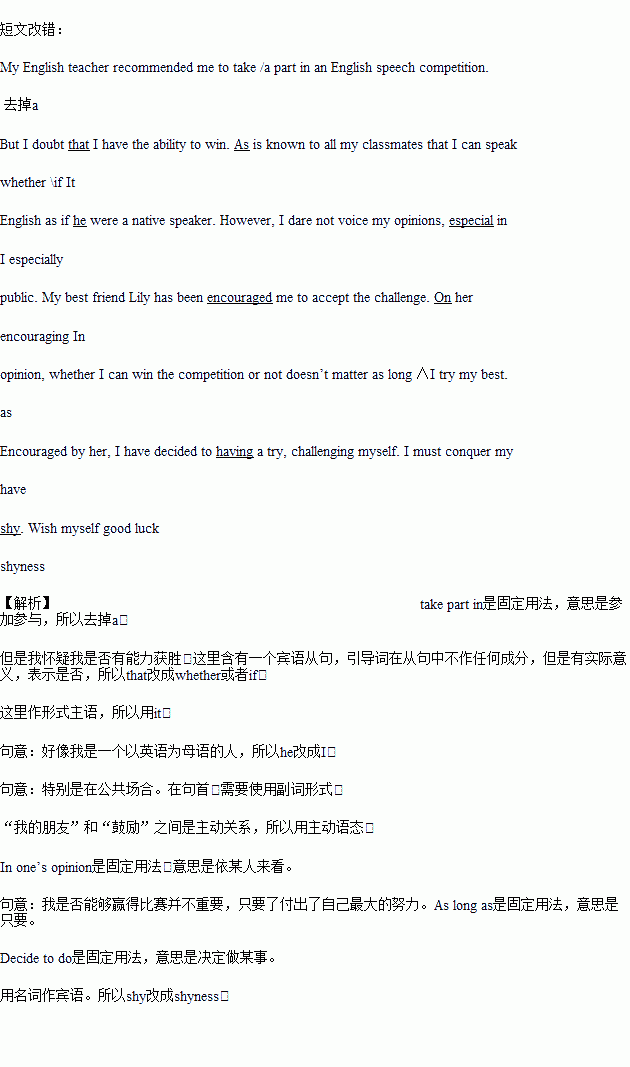ΧβΡΩΡΎ»ί
ΦΌΕ®”Δ”οΩΈ…œάœ Π“Σ«σΆ§Ήά÷°ΦδΫΜΜΜ–όΗΡΉςΈΡΘ§«κΡψ–όΗΡΡψΆ§Ήά–¥ΒΡΉςΈΡΓΘ ΈΡ÷–Ι≤”–10¥Π”ο―‘¥μΈσΘ§ΟΩΨδ÷–ΉνΕύ”–ΝΫ¥ΠΓΘΟΩ¥Π¥μΈσΫω…φΦΑ“ΜΗωΒΞ¥ ΒΡ‘ωΦ”ΓΔ…Ψ≥ΐΜρ–όΗΡΓΘ
‘ωΦ”ΘΚ‘Ύ»±¥ ¥ΠΦ”“ΜΗω¬©Ή÷ΖϊΚ≈Θ®ΓΡΘ©Θ§≤Δ‘ΎΤδœ¬Οφ–¥≥ωΗΟΦ”ΒΡ¥ ΓΘ
…Ψ¥ ΘΚΑ―Εύ”ύΒΡ¥ ”Ο–±œΏΘ®ΘήΘ©Μ°ΒτΓΘ
–όΗΡΘΚ‘Ύ¥μΒΡ¥ œ¬Μ°“ΜΚαœΏΘ§≤Δ‘ΎΗΟ¥ œ¬Οφ–¥≥ω–όΗΡΚσΒΡ¥ ΓΘ
ΉΔ“βΘΚ1. ΟΩ¥Π¥μΈσΦΑΤδ–όΗΡΨυΫωœό“Μ¥ ΓΘ
2. ÷Μ‘ –μ–όΗΡ10¥ΠΘ§Εύ’ΏΘ®¥”ΒΎ11¥ΠΤπΘ©≤ΜΦΤΖ÷ΓΘ
My English teacher recommended me to take a part in an English speech competition. But I doubt that I have the ability to win. As is known to all my classmates that I can speak English as if he were a native speaker. However, I dare not voice my opinions, especial in public. My best friend Lily has been encouraged me to accept the challenge. On her opinion, whether I can win the competition or not doesnΓ·t matter as long I try my best. Encouraged by her, I have decided to having a try, challenging myself. I must conquer my shy. Wish myself good luck.
 ‘ΡΕΝΩλ≥ΒœΒΝ–¥πΑΗ
‘ΡΕΝΩλ≥ΒœΒΝ–¥πΑΗΥφΉ≈…ώ÷ί °“ΜΚ≈≥…ΙΠΖΔ…δΘ§”νΚΫ‘±ΨΑΚΘ≈τ“≤ΈΣ ά»Υ÷θΡΩΘ§Υϊ «÷–ΙζΒΎ“ΜΈΜ3¥Έ…ΐ»κΧΪΩ’ΒΡ”νΚΫ‘±Θ§“‘œ¬ «ΥϊΫ” ήΦ«’Ώ≤…ΖΟΒΡΜΑ”οΫΎ―ΓΚΆΦράζΓΘ
ΓΑAfter the completion of Shenzhou?9 mission, we will prepare for the next. We will be ready for the selection of our motherland, to make new contributions to China's manned space program.Γ±
ΓΑI think during our lifetime, we need to set for us one dream after another and one goal after another, and to try our best towards the set objective(ΡΩ±ξ)Θ°Γ±
ΓΑThe Olympic Games is held every four years. I conducted my first space mission(»ΈΈώ) in 2008, and then again second in 2012, and now, another four years has just passed. I think I need to learn from Chinese Olympic shooter Wang Yifu, who has participated in nine Olympic Games. I still have a long way to go.Γ±
1966Ρξ10‘¬ | ≥ω…ζ”Ύ…ΫΈς‘Υ≥« |
1985Ρξ6‘¬ | ≤ΈΨϋ |
1987Ρξ9‘¬ | »κΒ≥ |
1998Ρξ1‘¬ | ’ΐ Ϋ≥…ΈΣΒΎ“Μ≈ζ÷–Ιζ”νΚΫ‘± |
2008ΡξΘ§2012ΡξΘ§2016Ρξ | Ζ÷±π≥Υ…ώ÷έΤΏΚ≈ΓΔΨ≈Κ≈ΚΆ °“ΜΚ≈‘Ί»ΥΖ…¥§…ΐ»κΧΪΩ’ |
ΓΨ–¥ΉςΡΎ»ίΓΩ
«κΡψΗυΨί“‘…œ’β–©≤ΡΝœ–¥“ΜΤΣ120¥ Ήσ”“ΒΡ»ΥΈοΫι…ήΓΘ
(1) Ϋι…ήΨΑΚΘ≈τΒΡ≥…≥Λάζ≥ΧΓΘ
(2) ΗυΨί≤ΡΝœΉήΫαΈ“Ο«”Π¥”Υϊ…μ…œ―ßœΑΒΫΒΡ”≈–ψΤΖ÷ (÷Ν…ΌΝΫΒψ)ΓΘ
ΓΨ–¥Ής“Σ«σΓΩ
1. ΈΡ÷–Ω… Β±‘ωΦ”–≈œΔ ΙΈΡ’¬Ν§ΙαΓΘ
2. –¥ΉςΙΐ≥Χ÷–≤ΜΡή÷±Ϋ”“ΐ”Ο‘≠ΈΡ”οΨδΓΘ
3. ΉςΈΡ÷–≤ΜΡή≥ωœ÷’φ Β–’ΟϊΚΆ―ß–ΘΟϊ≥ΤΓΘ

